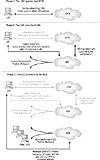
| Previous | Table of Contents | Next |
However, ATM requires that a point-to-point virtual circuit serve all connections. This requirement precludes the traditional media-sharing capabilities of Ethernet and Token Ring. To resolve this function, the ATM Forum LAN Emulation committee included in the specification a broadcast and unknown server, or BUS. Each ELAN must have its own BUS, which is responsible for resolving all broadcasts and packets that are addressed for unknown, or unregistered, stations. Under the original LANE 1.0 specification with Cisco ATM devices, without SSRP (Simple Server Redundancy Protocol), only one BUS is permitted per ELAN. Other vendors invented their own redundancy options to augment the specification. SSRP is a proprietary method of allowing redundancy in ATM LANE by permitting dual LECS and LES/BUS pairs.
 | Cisco’s implementation of LANE places the BUS on the same device as the LES. This design will likely change in the future, since it is inconsistent with other vendors’ offerings. |
LAN Emulation Configuration Server
While the LAN Emulation Configuration Server, or LECS, is not required in LANE, administrators frequently find that configuration is greatly simplified when it is employed.
The LECS is similar to Dynamic Host Configuration Protocol (DHCP) servers in the IP world. The workstation queries a server for all information that is needed to participate in the network. With DHCP, this is limited to IP address, default gateway, and DNS/WINS (Domain Name Service/Windows Internet Naming Service) servers, depending on implementation. In ATM, the LECS provides the address information for the LES and BUS to the LEC.
The Initial LANE Connection Sequence
The best way to understand the four components of ATM LANE is to visualize the initial startup sequence. This sequence is illustrated in Figure 2.9.
As shown, the client (LEC) must connect with the LES in order to join the ELAN. Most installations make use of the LECS; therefore, the LEC connects with the LECS to learn the address of the LES. Note that the LEC could also be configured with the address of the LES for its ELAN, or it could use the well-known address for the LECS. The well-known address is part of the LANE specification and is used when another method is unavailable.
Once the LEC connects with the LES and joins the ELAN, another connection is established with the BUS. Both of these VCs (virtual circuits) are maintained, but the LECS connection may be dropped. The LES typically maintains a connection to the LECS.
 | The CLSC Study Guide from Sybex provides more detail regarding ATM LANE and the Catalyst 5500 platform, including the LS1010. |

FIGURE 2 .9 The LANE connection sequence
|
Network Design in the Real World: ATM LANE Perhaps one of the greatest benefits of ATM LANE has been the enhancements to frame-based Ethernet. This is an ironic twist, but the complexities and expense of LANE frequently surpass the benefits afforded by many new technologies, including RSVP and GigabitEthernet. One must consider two specific factors regarding the viability of LANE. LANE was designed to provide an emulation of frame-based broadcast networks. This technology typically provides a number of benefits and detriments, including consistent ATM fabric latency (cell-based traffic is consistent; variable-frame is not) and support for greater bandwidth and integration with voice and video. The negatives include the cell tax (the overhead added by ATM), the SAR function (where frames are sliced into cells and reassembled back into frames), and the added complexity and relatively immature nature of the technology. For example, the PNNI (Private Network-Network Interface) and MPOA (Multiprotocol over ATM) functions (dynamic routing and route once/switch many functions) were just becoming deployable in the late 1990s, and many more features, including PNNI hierarchy, are still unavailable. Vendor interoperability is also a concern. The threat of ATM and ATM LANE was enough to make vendors add many features to the cheaper and more familiar Ethernet standards, including quality of service (QoS) and MPLS (Multiprotocol Label Switching) (another form of route once/switch many) technology. I have designed, installed, and supported both ATM LANE and ATM networks and would recommend that new LANE deployments be approached with great care. There are certainly times when it is the right solution, but it may be appropriate to consider the alternatives. Some of these are discussed in Chapter 13 in greater detail, including DTP (Dynamic Transport Protocol) and Packet over SONET (POS). Designers leaning toward using LANE need to consider supportability, cost, and features before committing to this technology. It is also important to note that the caveats regarding LANE do not necessarily include ATM—the two really need to be considered different technologies. ATM in the wide area network is virtually inevitable—most Frame-Relay cores use ATM, in addition to DSL (Digital Subscriber Line) and voice circuits. ATM does offer many advantages in this configuration. However, the features specific to LANE often do not offset the complexities of the protocol. |
| Previous | Table of Contents | Next |